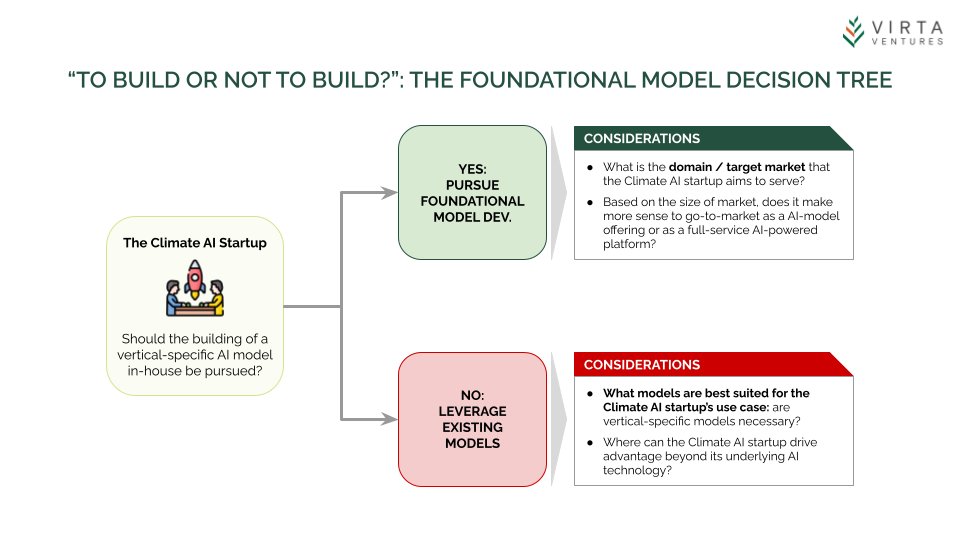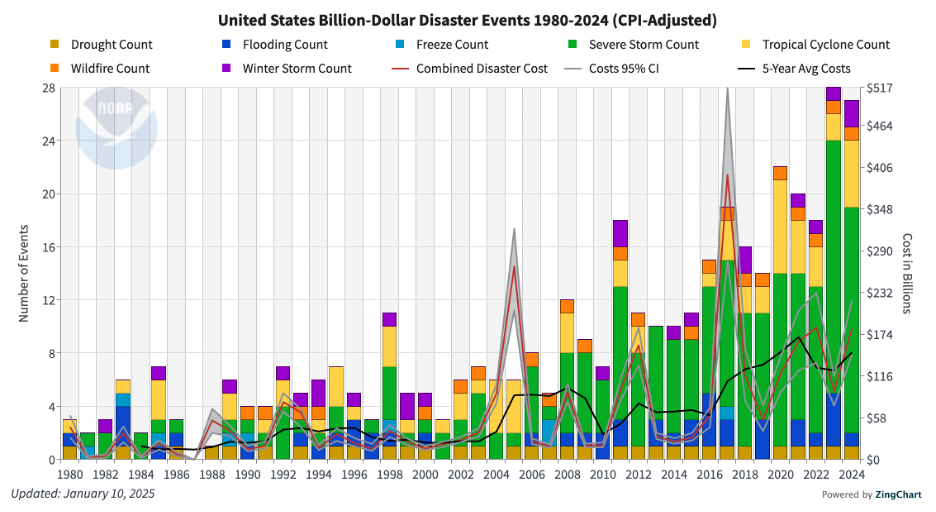AI x Climate Part 3: Foundational AI Models
By
Virta Ventures
ON
June 11, 2024

Welcome back to Virta Ventures’ AI x Climate series, a multi-part deep-dive into the intersection between AI development and the climate space. Part 3 of our series goes deeper into topics previously discussed: Part 1 and Part 2 are great reading if you’d like to catch up. Subscribe to our Substack to get our latest insights straight in your inbox!
In our previous installment of Virta’s AI x Climate series, we touched on a series of decision points for Climate AI companies: first, whether or not to train a foundational model from scratch and, second, what type of AI model to employ if in-house model-building isn’t pursued. The first crossroads in this decision tree is central to a startup’s strategy.
“To Build or Not To Build?”
To summarize this crossroads: climate AI startups, in the early stages, need to consider whether they want to invest in building a vertical-specific AI model in-house for their use case, or whether they can build on top of existing generalist models to drive value in their verticals. This decision requires thought on model requirements and on broader dynamics within a startup’s operations.
Model Requirements
To consider whether to build a foundational model from scratch, Climate AI startups need to consider the complexity and defensibility of the model that they seek to build.
Complexity
While we’ve observed decreases in costs of training more standard AI models, state-of-the-art models still require substantial capital to train. For instance, the training cost of GPT-4 was over $100M. Though few models will require comparable levels of sophistication to GPT-4, it still wouldn’t be far-fetched to expect substantial costs when training state-of-the-art models zero-to-one – costs that are likely far out of reach for most early-stage startups.
Startups need to consider the complexity required in a potential AI model and the resources required to achieve that complexity. For a startup that requires a greater amount of control over its AI capabilities but less complexity in those capabilities, training a more standard AI model may make sense. However, for startups requiring complex AI capabilities, leveraging an existing state-of-the-art AI model may be the only path forward due to the prohibitive costs of training a complex model from the ground up.
Defensibility
When building a model in-house, Climate AI startups put themselves at the risk of being outpaced by incumbents and larger AI companies who have the resources to build better and faster – think companies and institutions like IBM / NASA who have the resources to build generalist weather models for climate risk like Prithvi-weather-climate much more easily than up-and-coming startups can. Startups considering model development must consider what their potential model could bring to the table that generalist models do not, and whether those differentiation points are defensible over time.
Something to keep in mind: if an incumbent releases an AI model that can achieve the same use cases / feature set as a given startup’s AI model and more, then the incumbent organization OR new entrants can leverage the incumbent’s AI model to outcompete the startup on model complexity / sophistication. At that point of incumbent participation, it also becomes less fruitful for a startup to build a fully-fledged software solution around an in-house AI model, as competitors will have access to comparable or higher-horsepower solutions and the startup’s in-house model may become “legacy tech” far too quickly.
Broader Dynamics
Beyond logistics of the AI model that a Climate AI startup seeks to build, startups also need to consider the following dynamics within their broader operations that factor into how they tackle this model-building decision point.
Team Dynamics
Building a foundational model from scratch requires a startup to have a high concentration of AI / ML engineering talent. Having this concentration of talent is an organizational capability key to success in model development. Without existing access to AI talent on their teams, founders will likely have to turn to contracting or hiring engineering talent. The burning-hot talent market for AI / ML engineering talent makes this a high-cost, potentially prohibitive proposition for startups. For Climate AI companies, the fact that both Millennials and Gen Zs are willing to take on lower-paid roles to work in climate may help, but likely not enough to meaningfully lower the costs of hiring top AI / ML engineering talent.
If a startup’s founding team already has a strong concentration of top-of-the-line AI / ML talent on board, it might make sense for a startup to pursue model-building. A lack of existing AI / ML talent on a startup team is a huge constraint to model-building – a team in this position looking to build a model from scratch should think about whether the costs and effort of hiring necessary top-tier AI / ML talent make sense for their business.
Market Size + Economics
As we’ve discussed, building a state-of-the-art AI model from scratch is highly costly – potentially prohibitively costly – for startups. So is investing in net new AI / ML talent to support model development. That said, even building a more standard AI model without hiring on net new talent can be a significant cost investment.
Startups pursuing model development must be confident that their market size and revenue capture opportunity are large enough to warrant the cost investment of model development. Due to the size of model development costs, the commercialization opportunity of a climate tech solution with a first-party model should be much bigger than that of a climate tech solution leveraging out-of-the-box models.
Taking into account AI model needs (complexity and defensibility) and organization dynamics (team, market) to make a model-building decision is fundamental in determining a startup’s product direction. Following that come additional strategic tradeoffs to consider.
TO BUILD: Building a Foundational AI Model
Climate AI companies who decide to build a foundational AI model must consider “what comes next” following model development. Startups in this category have two options. They can go-to-market with a pure AI-model offering for B2B use: for instance, offering a foundational geospatial model for developer use in climate contexts. Or, they can build a full-service climate data platform with an in-house AI model as the “centerpiece” – think a full-service energy usage data insights platform built around a foundational energy-specific AI model.
Deciding which path to take takes some thinking around the domain / target market that a Climate AI startup aims to serve. With a large enough addressable market, providing a foundational B2B AI layer to a broad set of customers holds considerable appeal. In considering TAM, it’s important to note that the broader applicability of a foundational AI solution could allow the startup to target multiple types of customers, increasing a startup’s addressable market. As an example, climate prediction and climate risk AI models can serve use cases across insurance, commodity trading, clean energy infrastructure operations, and more.
Conversely, if the startup is targeting a smaller market segment, it may make more sense to integrate proprietary data and additional layers onto the foundational AI model and enable the creation of a full-stack climate data platform that can serve a greater amount of needs for a narrower set of customers. An example: if a startup is fully focused on serving regenerative agriculture, they should focus on deeply understanding the needs of regenerative farmers to ship value-add features powered by their proprietary AI. Through this, the startup makes their solution more “sticky” and deepens revenue generation with a smaller customer base.
To support “what comes next” in go-to-market, having strong go-to-market talent able to own and excel at strategy through execution becomes important for a startup’s success. Paid customer acquisition and retention become priority #1 after model development is complete: revenue allows the repayment of model development costs and unlocks a startup’s ability to steadily iterate and improve on its technology. Startups at this stage should begin to balance maintaining the strong roster of AI / ML talent required for model-building and development with growing a best-in-class go-to-market team to support revenue growth.
NOT TO BUILD: Leveraging Existing AI Models
Even without resources for building a model from scratch, integrating an existing AI model into a Climate AI data stack can allow a startup to build an AI-first B2B solution with a moat created from proprietary datasets, systems, and algorithms. In this case, the question of what AI model to select for use becomes relevant. Founders must consider whether generalist AI models are sufficient for their use case and, if not, whether vertical-specific foundational models are necessary, and whether these vertical-specific models are available for use.
Regardless of model type – when using an existing AI model, startups need to build their platforms in a way where they are able to capitalize on model progress. Without a mechanism for a startup’s platform to evolve with its adopted third-party AI model, the startup runs the risk of being out-innovated by new entrants taking full advantage of the AI model’s latest capabilities. Startups building on top of existing AI models should have a full understanding of where their underlying AI model supercharges their product and where model improvements can introduce new features and use cases.
Once a Climate AI startup gains momentum and achieves product-market fit, founders may contemplate the potential benefits of developing an in-house AI model to enhance the power and precision of their platform in the startup’s next phase. Given that startups in this phase have already completed the necessary vertical integration in their technological infrastructure to accommodate an AI model, this could emerge as a viable opportunity as startups continue to mature. This could introduce proprietary AI capabilities to a startup’s platform. That said, startups at this stage should still consider complexity and defensibility in making a model-building decision.
The rapid acceleration of AI progress creates new opportunities in the climate tech space and unlocks new ways to optimize our built systems for positive change. Across applications of existing AI models to climate tech and the development of new, domain-specific AI models for climate, we’re excited to see climate innovations emerge with AI at their centers.
Subscribe to our Substack to keep up with future insights in our AI x Climate series. To get in touch, connect with us here.
insights
We regularly publish thought pieces where we share lessons from renowned investors and delve into strategies for investing in the transformation of vital physical industries.







